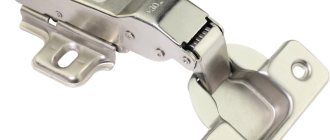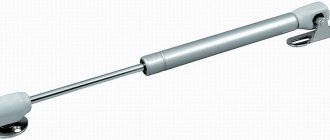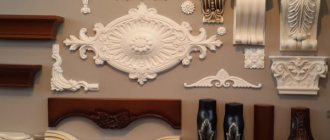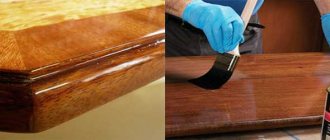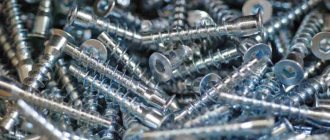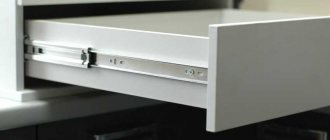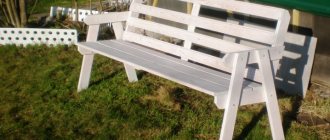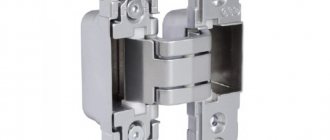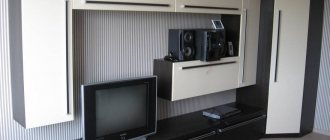Scope of use
Regardless of what type of edge is used, it is designed to protect the end parts of the product. Such a device is especially necessary when producing inexpensive furniture from chipboard or laminated chipboard. Since these materials contain harmful formaldehydes, which over time can evaporate their substances into the atmosphere. Edge materials allow you to cover raw edges, preventing the spread of fumes.
Another undoubted advantage of such a detail is the protection of wood materials from moisture getting inside. As you know, water penetrating into the pores of wood has a detrimental effect on it. If solid wood furniture is considered more resistant to moisture, then chipboard definitely needs an edge for the furniture.
Independent production of furniture parts implies the mandatory use of edging. If this is not done, then during operation the uncovered edges of the product will be subject to rapid wear. Possible causes include accidentally touching the edge, scratching with a sharp object, or carelessly closing the doors. This is why processing chipboard with edge material is so important in furniture production. To consolidate the information provided, it is necessary to highlight a number of functions performed by the edge - a special tape made from various raw materials for processing the edges of furniture:
- Beautiful appearance of the ends of the products. When shopping in a store, the buyer first of all looks at the aesthetic design. It is unlikely that he will want to install a sliding wardrobe where the internal shelves look unfinished, and their edges differ in color and structure from the facades;
- Protection from mechanical damage. Edge materials are designed to protect fragile chipboards from moisture and delamination. Chips and burrs caused by impacts can cause snags on clothing and scratches on the skin. The laminated surface of furniture can crack even when in contact with a hard object. If the edges of the parts are sealed with edging, the degree of damage and the chances of loss of attractiveness of the models are minimal;
- Protecting human health. As already mentioned, the edge plays an important role in maintaining the health of household members. The longer the furniture is used, the higher the risk of formaldehyde resins escaping from the chipboard.
When choosing products for your home, you should pay attention to these subtleties. They will help maintain the attractiveness of the furniture and extend its safe use.
Kinds
In modern furniture production, manufacturers offer several edging options. This is convenient for increasing or decreasing the cost of custom-made furniture. In addition, when making products yourself, the question arises of what type of furniture edge to choose. In order not to get confused, it is necessary to understand in detail the features of each, highlighting their pros and cons.
| Name | Description | Advantages | Flaws |
| Melamine | Sold in reels, attached only with glue. The edging tape can be single-layer or double-layer, and is made on the basis of paper. | There is a large selection of colors, the material easily follows the contours of the furniture, no additional equipment is required for the work - everything can be glued yourself. Melamine furniture edging is affordable. | Lack of protection against moisture, has a weak level of protection against mechanical damage. |
| PVC | Made from polyvinyl chloride. Available in two thicknesses, which are used for different parts of the furniture. The cost of the material is slightly more than its melamine counterpart. | The edge will provide protection from acids, alkalis and moisture. The assortment is represented by a rich color variety. PVC edges have a high level of protection against mechanical damage and are also considered durable. Another undoubted advantage is the non-flammability of raw materials. | The film is too rigid, which will not allow for quality processing of the product’s curves. In addition, it can only be fixed using a special machine. Self-attachment is excluded. |
| ABS | Manufacturing material: acrylonitrile butadiene styrene. This type is considered the most resistant to all types of damage. | The most durable edge of all presented. It does not contain chlorine, which is safe for human health. The ABS edge has a fade-resistant finish. It is soft and easy to cut, and does not emit toxic substances. | No significant disadvantages were found for this type of edge. The only thing that can stop you from choosing is the high cost, due to which the price of furniture will increase. However, this disadvantage is compensated by durability. |
| U-shaped from an overlay profile | The use of U-shaped furniture edges is used on products that are constantly exposed to moisture. | The special shape more reliably protects the ends from mechanical damage. The material can be fixed independently using glue. Additionally, it allows you to hide existing defects in the edges of furniture. Prevents any objects from sliding off the shelves or table. | Such framing is considered bulky and does not always look appropriate on furniture. |
Based on the information provided, we can conclude that ABS furniture edging is considered the most optimal for home use - it reliably protects the edges of products, preventing damage.
PVC
U-shaped
ABS
Melamine
Dimensions
To make edging on a countertop or cabinet look natural and attractive, it is best to have this process performed by professionals. Before choosing ready-made furniture or submitting your own products for edging, you need to not only decide on the type of edging, but also decide which size will be most suitable.
For each type of internal filling, it is necessary to use a different thickness of edge. So, for visible ends it is better to use a more reliable option.
Furniture edges are available in the following sizes:
- Paper or melamine edge - the thickness options for such a device are 0.2 or 0.4 cm. Manufacturers see no point in making it thicker, otherwise it will look ugly on the furniture. Self-adhesive furniture edges deserve special attention. Such devices are sold by the meter, as well as in reels of 200 m. Width - 26 mm;
- PVC – product thickness 0.4, 1 and 2 mm. Manufacturers often equip the front ends with thin options, and shelves and drawers with thick ones. The standard width is 26.5 mm, and reels are available in 150, 200 and 300 m;
- ABS - the width of such an edge is from 19 to 22 mm. Thickness can be 0.4, 1, 2 and 3 mm. For reliability, it is recommended to treat the edges with the strongest edging of 3 mm;
- Overlay U-shaped profile - available in widths of 16 or 18 mm for chipboard materials, thickness from 3 mm and above.
Before processing furniture, do not forget to measure the thickness of the material - for chipboard it is 16 mm, for countertops it will be 32 mm. Don’t forget that the main enemies of chipboard are fungus, mold and bacteria, so high-quality edging is considered a mandatory step.
PVC sizes
Melamine Edge Sizes
How to apply it yourself
At home, the easiest way to work is with self-adhesive melamine tape. To work you will need the following tools:
- knife for cutting off excess material (construction, shoe, stationery);
- a device for heating the working surface (iron or hair dryer);
- rags or piece of felt;
- fine sandpaper;
- a vice or an assistant who will hold the slab in a fixed position;
- roulette.
Features of using stickers on furniture, choice of materials and themes
After preparing the workplace, install and clamp the chipboard in a vice with the processed end facing up. Using a tape measure, measure the length of the end, and then the same length of the edge with an addition of 2 cm for error and shrinkage of the material when heated. The product is applied to the end and gradually warmed up along the entire length in small sections (35–40 cm). After heating, each zone, until the glue has hardened, is ironed with a rag or felt to level the surface layer. After the glue has dried, the excess tape is carefully trimmed with a knife, and the sharp edges are lightly sanded with sandpaper so as not to scratch the plate. Remove dust with a damp cloth.
When installing decorative tape without adhesive, you can use Moment rubber adhesive, after waiting a certain time before pressing the edge to the end. Other adhesive compositions are also used, in which the technology must be maintained over time. In the same way, you can apply a thin PVC edge yourself. The thick variety is difficult to trim after application - special tools are needed.
Furniture edges are an important element of walls, cabinets, shelves, and other furniture. With the right choice, it will last for many years, protecting the base material from damage and exposure to adverse factors. The main thing is to approach the purchase responsibly.
Edge gluing
Criterias of choice
Furniture edging significantly improves the appearance of cabinets, drawers, tables, and any other cabinet furniture. Today it is available in various colors, and choosing an option to match the shade of the furniture will not be difficult. To make the selection process easier, and the result to please the family for many years, pay attention to the following selection criteria:
- Material – speaking of material, edgings can be divided into paper, plastic and rubber. The pros and cons of each of them have been described above. When choosing, you should pay attention to its compatibility with the material of production of the furniture itself;
- Width - popular sizes vary between 22 and 38 mm, so before edging the product, it is worth choosing the optimal width - it should completely hide the edges of the product;
- Thickness – today manufacturers use edges from 0.2 mm thick. It is necessary to take into account the purpose and storage conditions of the furniture in order to select the required thickness parameter;
- Presence of an adhesive layer. This criterion is important for people who want to secure the edge to the product themselves. If the device does not have an adhesive layer, then you will not be able to make the edging yourself;
- Type of fastening - there are rigid, overhead and mortise edges. Depending on the purpose, choose one of the options. The mortise type is also divided into T-shaped and U-shaped;
- Surface type - edge coating can be glossy, matte, embossed or embossed. Take this criterion into account to improve the appearance of the furniture.
Having studied all the indicators of furniture edges, you can safely go for a new set of furniture. When purchasing, pay special attention to the quality of processing of the edges and end parts. It is worth additionally asking the seller about the method of fixing the edge. By purchasing furniture products with durable edges, you can ensure they have a long service life.
Fastening PVC and ABS edging
Plastic edging tapes, theoretically, can simply be fixed to the edge of the furniture, but this is extremely unreliable. Additional fixation with glue is preferable.
To attach the T-shaped profile, you will have to lay a recess along the entire edge to be processed. The easiest way to do this is with a milling machine. If you have the skill, it will be replaced by a drill with a circular attachment. However, in general the profile is intended for professionals.
To fix PVC or ABS edges at home, use PVC glue, as well as universal compounds “Moment” and “88-lux”; it is desirable that they be marked “for PVC” or “for ABS”.
Professionals use hot melt adhesives, which are part of a range of thermoplastics. When heated, they become highly elastic, and when cooled, they instantly turn into a solid state. The high fluidity and drying strength of the adhesives is due to the ethylene polymer with vinyl acetate they contain. The main disadvantage of hot melt adhesives, of course, is the need for appropriate equipment for the job.
When working with any border, try to calculate the sequence of pasting so as to avoid joints. Go around the corners with a profile - preferably they should be rounded. If the corners are normal, a thick (PVC or ABS) profile will not go around them, and the melamine edge will most likely break. In this case, you will have to make joints at the corners, which must be sanded at the end so that they are smooth. If you run your hand along the edge of the part, the roughness should not be felt.
If the factory edge is damaged or partially fallen off, remove it and replace it with a new one. A little effort and the table is like new!
You will learn about what types of edges there are, as well as methods for gluing them and how to glue the edges with an iron and hairdryer from this article.
- The most common type is melamine edge with paper-based glue
. Used for finishing interior areas of furniture. Available, inexpensive, but not the highest quality option. Does not tolerate moisture and wears out quickly. Easily glued at home with a simple iron. - T-shaped flexible profile - is a T-shaped strip, it is inserted into a slot in the side of chipboard or MDF. It is convenient to replace the damaged element in the future without disassembling the furniture. Installation requires a milling machine.
- PVC edging - reliably protects the ends of furniture from damage, is wear-resistant and resistant to moisture. To glue PVC edging, you will need an edge processing machine, so using this type of edges at home is difficult.
- ABS plastic is an eco-friendly option without chlorine. Valued for its resistance to high temperatures and physical damage.
All options can be divided into two subtypes - edges without glue
and with glue.
Average cost of a profile per linear meter:
- PVC 0.4 mm thick - about 25 rubles,
- PVC 2 mm thick - about 40 rubles,
- Melamine material for chipboard – about 25 rubles.
In our country, products from the Rehau company are actively used, which offers a large selection of colors, as well as different tape widths from 15 to 45 mm.
To simplify the work, you can use various specialized furniture programs that will calculate how much material is required for gluing the edges.
